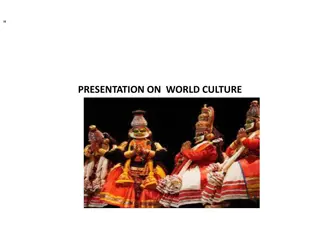Understanding World Cultures: Insights into Eastern, Latin, and Middle Eastern Traditions
Delve into the rich tapestry of world cultures through an exploration of Eastern, Latin, and Middle Eastern traditions. From the shared patterns of behavior to the unique influences of religion and language, discover the diverse characteristics that shape societies across different regions.
Download Presentation

Please find below an Image/Link to download the presentation.
The content on the website is provided AS IS for your information and personal use only. It may not be sold, licensed, or shared on other websites without obtaining consent from the author. Download presentation by click this link. If you encounter any issues during the download, it is possible that the publisher has removed the file from their server.
E N D
Presentation Transcript
" PRESENTATION ON WORLD CULTURE
Culture is the characteristics and knowledge of a particular group of people, encompassing language, religion, cuisine, social habits, music and arts. The Center for Advance Research on Language Acquisition goes a step further, defining culture as shared patterns of behaviors and interactions, cognitive constructs and understanding that are learned by socialization. Thus, it can be seen as the growth of a group identity fostered by social patterns unique to the group. "Culture encompasses religion, food, what we wear, how we wear it, our language, marriage, music, what we believe is right or wrong, how we sit at the table, how we greet visitors, how we behave with loved ones, and a million other things," Cristina De Rossi, an anthropologist at Barnet and Southgate College in London, told Live Science. The word "culture" derives from a French term, which in turn derives from the Latin "colere," which means to tend to the earth and grow, or cultivation and nurture. "It shares its etymology with a number of other words related to actively fostering growth,
Eastern culture Eastern culture generally refers to the societal norms of countries in Far East Asia (including China, Japan, Vietnam, North Korea and South Korea) and the Indian subcontinent. Like the West, Eastern culture was heavily influenced by religion during its early development, but it was also heavily influenced by the growth and harvesting of rice, according to the book "Pathways to Asian Civilizations: Tracing the Origins and Spread of Rice and Rice Cultures" by Dorian Q. Fuller. In general, in Eastern culture there is less of a distinction between secular society and religious philosophy than there is in the West.
Latin culture Many of the Spanish-speaking nations are considered part of the Latin culture, while the geographic region is widespread. Latin America is typically defined as those parts of the Central America, South America and Mexico where Spanish or Portuguese are the dominant languages. Originally, the term "Latin America" was used by French geographers to differentiate between Anglo and Romance (Latin-based) languages, according to the University of Texas. While Spain and Portugal are on the European continent, they are considered the key influencers of what is known as Latin culture, which denotes people using languages derived from Latin, also known as Romance languages.
Middle Eastern culture The countries of the Middle East have some but not all things in common. This is not a surprise, since the area consists of approximately 20 countries, according to PBS. The Arabic language is one thing that is common throughout the region; however, the wide variety of dialect can sometimes make communication difficult. Religion is another cultural area that the countries of the Middle East have in common. The Middle East is the birthplace of Judaism, Christianity and Islam.
African culture The continent of Africa is essential to all cultures. Human life originated on this continent and began to migrate to other areas of the world around 60,000 years ago, according to the Natural History Museum in London. Other researchers, like those from Estonian Biocentre in Tartu, believe that the first migration may have been much earlier, as early as 120,000 years ago. Researchers come to these conclusions by studying human genomes from various cultures to trace their DNA to common ancestors. Fossil records also factor into some of these theories. Africa is home to a number of tribes, ethnic and social groups. One of the key features of this culture is the large number of ethnic groups throughout the 54 countries on the continent. Nigeria alone has more than 300 tribes, for example. Currently, Africa is divided into two cultural groups: North Africa and Sub-Saharan Africa. This is because Northwest Africa has strong ties to Middle East, while Sub-Saharan Africa shares historical, physical and social characteristics that are very different from North Africa, according to the University of Colorado. The harsh environment has been a large factor in the development of Sub-Saharan Africa culture, as there are a number of languages, cuisines, art and musical styles that have sprung up among the far-flung populations.
Cultures of the world Western culture Anglo America Latin American culture English- speaking world African-American culture Indosphere Sinosphere Islamic culture Arab culture Tibetan culture
Surprising Customs from Around the World
Pointing with lips in Nicaragua While gestures of the hand are often subject to customary variation across cultures, few can claim this phenomenon extends to contortions of the mouth. In Nicaragua, it is common to point with the lips instead of the thumb or index finger like the majority of the world. Wondering just how exactly a person points with their lips? It all starts by puckering up. Once a Nica has their duck face on, they can direct their lips forward or side-to-side to indicate what it is they d like to point out. The lip point is typically used in conversation to indicate something that is happening nearby. Kissing in France Pretty much every culture has specific rituals for greeting. Latin American cultures and the Romance cultures share the common custom of kissing both close loved ones and new acquaintances on the cheek as a form of salutation. Yet, the French seem to take this to a whole new level with the number of nuances involved in their kissing rituals. For one, the rules vary for men and women. Secondly, the number of kisses required to complete the greeting changes from region to region. What s more is that French people are expected to greet each person at a party or gathering upon arrival whether they know the attendees or not. This is only a brief overview of the customary kissing practices in France.
Spitting on the bride at weddings in Greece This practice was popularized thanks to the 2002 film, My Big Fat Greek Wedding. Spitting in Greek cultures is a kind of good luck charm that is supposed to help ward off the devil. Today, the custom typically doesn t involve guests hocking loogies at the newlywed bride. Instead, it has evolved into a more symbolic act where guests mainly forcefully utter ftou ftou ftou. Greeks do this at other special occasions too, including baptisms in order to acknowledge the beauty and good health of the baby. Spitting can even be done as a superstitious measure to ward off evil during regular conversation. September 12 is the Day of Conception in Russia Cultures typically approach sex, marriage and reproduction in unique ways. Russia may take the cake on this in terms of institutionalized acceptance, though. This is because the declining birth rates of the country coupled with the unequal proportion of women to men and the alarmingly short lifespans of Russian men pose as serious concerns for the society. Therefore, the government has instated a public holiday created solely to give couples time off from work in order to have sex in the hopes that doing so will result in pregnancy. Parents whose babies are born exactly nine months later can even win prizes for helping to keep the Russian bloodline going.
Groundhog Day in the U.S. Many countries have rather strange holidays that commemorate their distinct histories. While the United States is a rather new nation, it has been around long enough to develop one odd holiday known as Groundhog Day. Since 1887, on February 2, the nation waits patiently to see if the groundhog, Punxsutawney Phil, saw his shadow. If he does, it means there will be six more weeks of winter. Perhaps even more bizarre is the Punxsutawney Groundhog Club s Inner Circle of dedicated men who, according to tradition, tend to the groundhog while dressed in black suits and top hats at the lighthearted Groundhog Day ceremony each year.
Tipping in the U.S. Another odd custom associated with the United States is its intricate tipping culture. Unlike many other countries who don t tip at all or who only tip in small amounts when the food was particularly good, tipping is rather mandatory at most restaurants in the U.S. In fact, it is expected that patrons leave between 10-20 percent of the bill in tips. Wait staff rely on this gratuity for a living because legal wages for waiters are low. Further, there are rules for tipping bartenders, delivery people and other service personnel. While some criticize this practice as irrational, there s no doubt that tipping culture in the U.S. gives an incentive for waiters and waitresses to provide better service. Hanging out in cemeteries in Denmark While cemeteries are the sites of spooky lore in many countries, this is not so much the case in the ever so secular Denmark. Many people might prefer to hang out in parks, but the Danes find it becoming to convert their cemeteries into areas for socializing, a rather pragmatic use of space we might add. These cemeteries are well manicured and teeming with locals when the weather finally begins to warm up.
Kneeling or lying prostrate as greeting in Nigeria For members of the Yoruba people, an ethnic group that largely resides in Nigeria, greeting rituals are taken quite seriously. This is especially true in regards to greeting elders. When an adult approaches, Yoruba youths are expected to drop to their knees in greeting. More specifically, women kneel when greeting, and men typically lie prostrate. These gestures are a sign of respect and deference for the elders of the community. Interestingly, this custom is one that distinguishes Yoruba peoples from other ethnic groups in Nigeria, including the Bini and the Kalabari. Using the left hand for things In some countries, using the left hand for eating or other activities is considered quite rude and insulting. Oftentimes, cultures in these countries use the left hand for cleaning themselves after using the toilet, and, therefore, it is considered dirty. This rule applies to several places around the world including much of the Middle East, Sri Lanka, India and parts of Africa. To be safe, always use your right hand for greeting, handling merchandise, exchanging money, and, of course, eating while spending time in any of these parts of the world.
Pointing with the thumb in Malaysia Some countries find the act of pointing with the index finger to be abrasive and rude. While members of most cultures would probably agree that pointing fingers, both literally and figuratively isn t exactly the nicest thing in the world, in countries like Slurping in Japan Most societies around the world have rules about table etiquette. For western cultures, noisily consuming food is considered rude. In Japan, however, making slurping sounds while eating has an entirely different meaning. This might have something to do with the fact that in western countries, noodles are properly consumed by twirling them on a spoon before putting them in the mouth. Meanwhile, the Japanese simply slurp up their noodles without contorting them first, an act that is naturally noisier than the former. Making slurping sounds when eating noodles in Japan is a way of indicating that you re really enjoying them. Some scientists even argue slurping invites air into the palate and actually enhances the noodles flavor.























